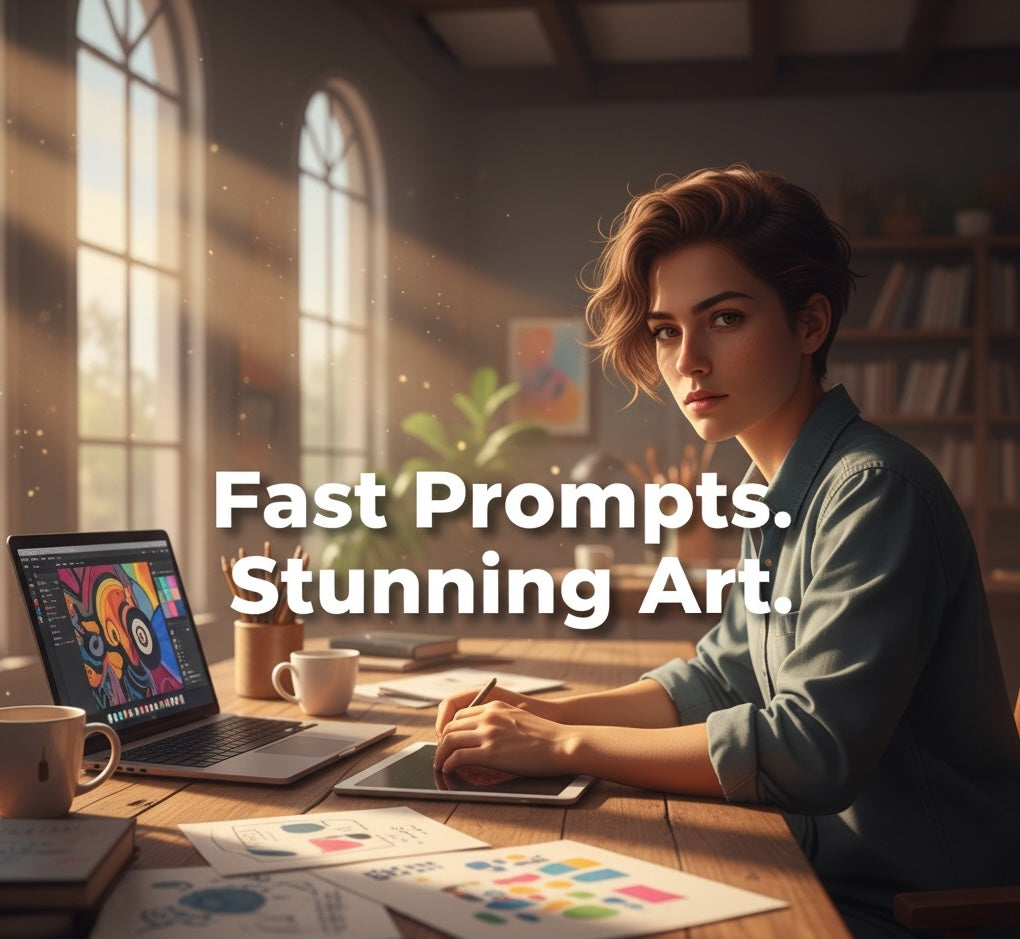Why Smart Prompting Decides the Beauty of AI Art
How Generators Translate Words Into Visual Structure
Image models map words into mathematical representations that shape color, composition, texture, and light. A single clause such as “soft rim light” alters edge contrast, while “lens flare at f/1.8” compresses depth. Terms like “flat color” or “triadic palette” steer the engine toward specific visual harmonies. When phrasing is concrete and sensory, the model gains enough structure to create scenes that feel purposeful instead of random.
Visual Psychology That Guides Aesthetic Judgments
Viewers instinctively read balance as calm, high contrast as drama, and warm hues as emotional proximity. The most reliable way to direct these perceptions is through language that encodes intent. “Symmetrical framing with centered horizon” signals compositional stability; “split lighting on cheekbone” signals tension. For those seeking repeatable control in Midjourney, study structured Midjourney formulas for visual perfection to see how phrasing choices translate into dependable visual outcomes.
The Blueprint of a High-Performance Image Prompt
Core Components That Shape Results
Effective prompts rely on five essential elements:
| Component | What to Specify | Typical Impact | Example Phrase |
|---|---|---|---|
| Subject | Main object or character | Defines composition | “Portrait of a violinist” |
| Context | Setting or environment | Adds realism | “Backstage hallway, tungsten bulbs” |
| Style | Medium or aesthetic | Directs look | “Kodachrome, 1970s editorial” |
| Mood | Emotional tone | Guides color and light | “Quiet anticipation, muted shadows” |
| Detail | Technical adjustments | Improves precision | “85mm at f/1.4, soft rim light” |
Language Techniques That Increase Realism
- Use verbs over adjectives: “Backlit fog diffuses signage” is more effective than “mysterious fog.”
- Camera terminology controls scale: “Low angle, 24mm, shallow focus” changes perspective.
- Lighting conveys emotion: “North-facing window with sheer curtain” ensures consistency.
- Material vocabulary defines credibility: “Anodized aluminum with micro scratches” clarifies surface texture.
Mistakes That Confuse Models and How To Repair Them
Avoid stacking too many style tags or using generic words like “epic.” Keep only descriptors that change visual facts. Always specify negative conditions such as “no text overlays” or “clean background” to prevent clutter.
From Idea To Prompt: A Repeatable Working Routine
The Five-Step Conversion From Concept To Render-Ready Text
- Write a one-sentence intent that identifies subject and purpose.
- Translate the intent into the five key components.
- Add two optical controls for lens and lighting.
- Include negatives that prevent irrelevant artifacts.
- Trim the language to essential descriptive words.
Example Transformation
Plain idea: “A serene reading scene that feels timeless.”
Structured prompt: “Young reader in a window bay, morning light, worn linen cushions, Kodachrome color, quiet anticipation, 50mm at f/2, soft rim light, dust motes visible, no text overlays.”
Using Conversational AI To Multiply Good Prompts
Turning Raw Thoughts Into Structured Variations
Conversational models excel at turning broad ideas into structured image instructions. Ask for multiple versions that keep the subject constant but adjust lens, lighting, or color palette. This structured exploration sharpens creative control.
Scaling Ideation Across Campaigns
High-output creators can automate consistency by using prompt frameworks. Sets of reusable prompt patterns yield themed visual series. Those building creative pipelines can consult advanced ChatGPT frameworks for creative detailing to maintain linguistic clarity and stylistic discipline across campaigns.
High-Volume Workflows Without Losing Consistency
For creators managing regular content production, scalable prompt systems are essential. Bulk creative ideation systems help maintain brand tone, subject coherence, and stylistic uniformity across multiple releases.
Google Veo 3 For Precision-Driven Control
What Structured Prompt Data Unlocks
When encoded in structured form, prompts can define contrast, saturation, and dynamic range predictably. Template-based structures ensure consistent aesthetic decisions. Explore JSON prompt templates for video-grade image creation to understand how precise fielded attributes produce balanced, cinematic-quality frames.
Libraries That Shorten Setup Time
Reusing foundational prompt templates accelerates project starts and maintains brand tone. Teams developing cohesive series can work efficiently with Veo 3 repositories for rapid content production to ensure continuity in light, tone, and spatial design.
Speed With Taste: Iteration Methods That Protect Quality
Batching And Seed Control
Seed values ensure visual consistency across iterations. Batch testing three or more slight prompt changes helps compare results quickly. Micro-edits—altering only one variable per test—preserve intent and avoid drift.
Reference-Guided Consistency
Reference imagery, palette charts, and controlled lighting language maintain unity. Saving outputs with prompt notes ensures future reproducibility.
A Practical Check Cycle
- Generate multiple drafts with varied light sources.
- Select the cleanest silhouette.
- Modify one optical property at a time.
- Finalize only after composition and tone align.
Prompt Patterns That Consistently Produce Quality
People And Portraiture
- “Natural window light, eye level, 85mm at f/2, subtle catchlight, neutral grading.”
- “Split lighting with soft fill, gentle contrast curve, background two stops down.”
Products And Objects
- “Three-quarter angle on seamless background, controlled reflections, polarized highlights.”
- “Macro at f/8, left softbox, right bounce, contained shadow falloff.”
Architecture And Spaces
- “Golden hour light, wide lens minimal distortion, verticals corrected.”
- “Night scene, practical lights only, long exposure look, balanced highlights.”
Illustration And Stylization
- “Limited triadic palette, ink line consistency, paper texture visible.”
- “Painterly brush simulation, warm bias, subtle canvas grain.”
Social Platforms And Visual Performance
Why Some Images Stop The Scroll
Images that stand out in feeds balance high contrast, emotional cues, and clean subjects. Prompts that ask for “clear subject separation” and “gesture suggesting motion” perform best on smaller screens.
Prompts That Align With Platform Behavior
- Short-form video platforms reward dynamic gestures and narrative hooks.
- Grid-based galleries value uniform lighting and palette cohesion.
- Vertical feeds reward strong central contrast to maintain clarity.
Resources For Social-Ready Ideation
Creators seeking social-first engagement can benefit from viral content prompt packs for TikTok creators that illustrate visual rhythm, pacing, and emotional resonance tailored to fast-scrolling audiences.
Quality Control: A Practical Review Framework
Visual Integrity Checklist
- Strong silhouettes readable at thumbnail scale.
- Consistent light direction and color harmony.
- Balanced focal points and supporting details.
- Texture realism without excessive sharpness.
Language Integrity Checklist
- Every adjective defines a visible property.
- Style cues are compatible.
- Negative clauses prevent clutter.
- Optical terms match intended perspective.
Reusable Prompt Blocks For Real Projects
Portrait Session Block
Subject: “Candid half-length portrait”
Context: “Studio corner with muslin backdrop”
Style: “Editorial color, fine grain”
Mood: “Focused, calm”
Detail: “85mm at f/2, window key, foam fill, clean background”
Lifestyle Product Block
Subject: “Ceramic mug on wooden table”
Context: “Morning kitchen, rising steam”
Style: “Natural light commercial”
Mood: “Warm and calm”
Detail: “50mm at f/2.2, backlight through curtain, gentle haze”
Architecture Block
Subject: “Modern atrium with hanging plants”
Context: “Overcast sky, diffuse top light”
Style: “Documentary neutral tone”
Mood: “Open and quiet”
Detail: “24mm corrected verticals, balanced white, minimal bloom”
Troubleshooting: When Results Miss The Mark
If The Subject Looks Warped
Raise f-number for depth, reduce extreme focal widths, or specify “orthographic proportion.”
If Colors Fight The Mood
Constrain palette using color theory terms like “analogous cool with warm accent.”
Set white balance references to neutral materials.
If Detail Looks Harsh Or Plastic
Remove “ultra sharp” modifiers.
Add “microtexture preserved” or “film grain mild.”
Asset Management For Prompt Libraries
Tagging And Version Control
Label prompts by subject, light, and lens.
Store example outputs and notes to map cause and effect.
Maintain a consistent file structure for retrieval.
Collaboration Guidelines
Adopt shared terminology and dictionaries.
Keep consistent naming across contributors.
Include visual references for tone and texture consistency.
Ethical Guardrails For Sustainable Practice
Respect For Originality
Avoid naming living artists or duplicating signature styles. Use genre-based descriptors instead of personal references.
Clarity About Synthetic Media
Label AI-assisted images transparently where appropriate. Transparency enhances credibility and supports honest communication.
Licensing Awareness
Follow platform terms and keep records of prompt versions. Documentation protects both creators and clients when publishing commercially.
Monetization Pathways That Reward Quality
Where To Share Or Sell Responsibly
Creators can market structured prompts or digital artworks through trusted digital prompt hubs that emphasize originality, curation, and learning. Those crafting printable or collectible digital pieces can explore handmade digital art marketplaces thriving with AI creations to reach audiences who value story-driven design.
Packaging For Buyers Or Teams
Offer themed prompt series with consistent lighting language. Include visual references and short usage notes to guide application.
Comparison Snapshot For Placement Decisions
| Channel Type | Audience Fit | Creative Strength | Best Use Case |
|---|---|---|---|
| Curated prompt libraries | Digital creators | Structured repeatability | Campaign consistency |
| Handmade digital marketplaces | General creative audience | Story and originality | Collectible assets |
| Community showcases | Enthusiasts | Feedback and refinement | Early concept testing |
Tables That Speed Creative Decisions
| Lever | Increase For | Decrease For | Notes |
|---|---|---|---|
| Focal length | Flat perspective | Dramatic depth | Adjust for subject size |
| Aperture | Isolation | Context | Wider openings add blur |
| Light size | Soft texture | Hard edge | Larger sources smooth transitions |
| Color spacing | Vibrancy | Calm tone | Triadic brightens, analogous softens |
| Local contrast | Pop | Subtlety | Balance to prevent artifacts |
Case-Style Walkthroughs That Tie It Together
Brand Story Mini Series
Brief: Build three cohesive images expressing craftsmanship and everyday utility.
Prompts:
- “Close portrait of maker, 85mm at f/2, soft window key, neutral palette, texture preserved.”
- “Hands shaping material, macro at f/8, balanced reflection, neutral background.”
- “Product in use, 50mm at f/2.8, gentle backlight, consistent contrast curve.”
Editorial Concept Grid
Brief: Create six tiles that read as one story.
Approach: Fix lens and palette while varying gesture and perspective to maintain rhythm across the grid.
Learning Resources That Reinforce Skill
Vocabulary To Master Over Time
- Camera: focal length, aperture, exposure ratio.
- Lighting: key-fill balance, diffusion, edge light.
- Surface: specularity, roughness, patina.
- Color: hue bias, split tone, saturation density.
Practice Routines That Build Fluency
- One subject, three light conditions.
- One palette, three moods.
- One lens, multiple distances with notes on distortion.
Prompt Systems That Encourage Responsible Speed
Templates That Prevent Creative Drift
A structured template keeps artistic focus stable:
- Subject and context in one concise sentence.
- Add style, mood, and optical controls.
- Define negatives.
- Reserve space for revision notes.
Libraries That Evolve With Use
Promote strong templates, retire inconsistent ones, and document each improvement. Over time, this library becomes a personal language of clarity and control.
Expanding Visual Intelligence Across Cultures and Platforms
Regional Aesthetics and How Prompts Reflect Local Identity
Cultural nuances define visual appeal. East Asian visuals emphasize minimalism and symbolism, while Western campaigns often focus on narrative and contrast. Prompting with localized descriptors such as “Tokyo side-street at dusk, balanced composition” or “New York editorial lighting, energetic framing” improves authenticity.
Adapting Language for Global Discoverability
Use standardized, descriptive terminology rather than regional slang to ensure clarity across models and markets. “Soft diffused daylight through linen curtain” communicates universally, while idiomatic phrases may misfire in translation.
Integrating Voice and Visual Search Cues
For multimodal or voice search optimization, phrase prompts naturally as intent-based sentences:
- “Show a tranquil workspace with natural light.”
- “Generate a cinematic portrait with dramatic contrast.”
This approach enhances discoverability for generative and voice-first systems.
Building Cross-Disciplinary Prompt Fluency
Prompt writing links design, storytelling, and photography. By learning to express lighting, gesture, and tone precisely, professionals connect language to visual craft across creative industries.
Sustainable Growth Through Shared Standards
As global creators adopt AI tools, shared glossaries, ethical frameworks, and open vocabularies ensure inclusivity and accountability. Standardized communication supports responsible growth while preserving artistic diversity.


